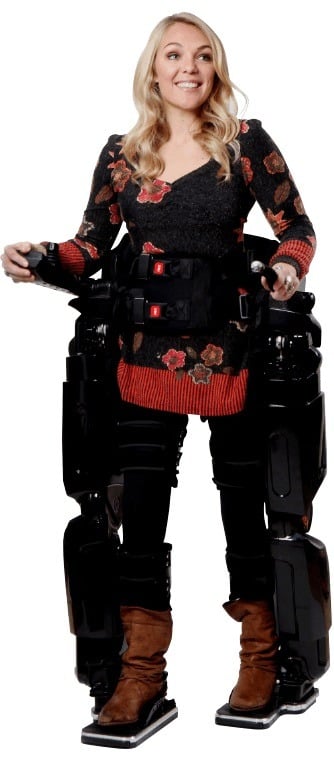9 Robotic Exoskeleton Stocks For Investors to Try On
Table of contents

In a recent article, we looked at a very interesting subcategory of robotics called “exoskeletons”. Also called “wearable robots”, exoskeletons aren’t just used to shoot laser beams at attacking alien scum in movies, but they are also seen as having a tremendous growth potential for investors. Technological advances like 3D printing and better lithium batteries mean that exoskeletons are now economically viable to produce. Market projections put the exoskeleton market at between $1.8 to $3.3 billion by 2025, from an estimated size of just $25 million in 2015. While the methods used to determine these projections are probably akin to throwing darts, researchers agree that the growth is there and competition is already fierce with close to 60 companies reaching different stages of development in the field. In this article, we’ll look at those companies that are accessible to retail investors. First we’ll look at 4 pure-play exoskeleton stocks, then look at 5 larger industry giants.
Looking at the lineup, it’s evident that the technology has branched off in 3 distinct directions: healthcare, military and industrial uses.
Ekso Bionics


Currently priced above $100k, EKSO is targeting the estimated 50,000 rehabilitation clinics globally. The Ekso team has also released an industrial strength assistance tool called ZeroG for construction, manufacturing and warehouse environments. 25% of revenues were attributed to this “industrial” segment last quarter compared to 0% in the same quarter the year prior. Still, the primary focus is on the health offering with EKSO wanting to see 1 million people walking in these suits by 2022.
ReWalk Robotics
Israeli company ReWalk Robotics (NASDAQ: RWLK) is another small cap stock targeting healthcare applications for exoskeletons that allow wheelchair-bound individuals to stand and walk once again. RWLK has developed an FDA approved line of exoskeleton suits called “ReWalk” for personal as well as hospital rehabilitation use. The suit’s technology “recognizes the forward tilt of the upper body, and executes steps accordingly, mimicking the natural gait of the legs”. The Company hopes to convince insurers to include it in their coverage.

ReWalk had an IPO in 2014, and since then their share price has declined steadily giving them a current market cap of around $32 million. In September 2016, ReWalk marked the milestone of their 100th personal exoskeleton sold (at a price of $77k each) along with an additional 150 exoskeletons sold to medical institutions. They’ll need to do better than that though as they continue to incur significant losses.
Cyberdyne
Cyberdyne (TYO: 7779) spun out form the University of Tsukuba, Japan in 2004 and had an IPO on the Tokyo Stock Exchange in 2014 giving them a present day market cap of $3 billion. Their creation, the Hybrid Assistive Limb (HAL), is a lower body exoskeleton available for medical purposes and and non-medical living and labor support. HAL is able to read the brain signals for movement which faintly leak to the skin, and move accordingly which in turn provided the movement’s feedback to the brain, an important first step in the rehabilitation process. HAL is priced between $14-19k making it much cheaper than its competitors above, and it is also available for rent.

Cyberdyne has launched variations of the medical exoskeleton for lower limb, single joint and lumbar support, and is currently developing a full body version and a disaster recovery suit as well. Their main HAL offering is complemented by the somewhat unrelated duo of a table interface resembling a huge multi-user tablet and a rather large automated cleaning robot that is able to use elevators. A report issued last year by notorious short seller Citron predicted that Cyberdyne stock will lose 85% of its value, something that prospective investors should probably take a look at.
Rex Bionics


The team is conducting multiple clinical trials to support their claims of rehabilitation potential for the suits. RXB has been operating at a loss for the past 3 years, with revenues suggesting sales of just a handful of exoskeleton suits so far.
Now that we’ve looked at 4 pure-play exoskeleton stocks, let’s take a look at 5 larger corporations that are playing in this space as well. While investing in these stocks won’t give us much exposure to the growth of exoskeletons, you need to know who all the key players are.
Parker Hannifin


With the FDA clearance for personal use under their belt, Parker is now working to have insurance coverage for their $80k lower body suit, which is lighter and nimbler than its competitors. It comes with an optional Therapy Kit for clinicians, and has a strong background in clinical research summarized on their website.
Panasonic
Panasonic (TYO: 6752) has an exoskeleton offering that is dwarfed by their total market cap of $26.5 billion, but it still remains interesting. Panasonic developed a range of suits with their in-house venture company Activelink for industrial use and another one to assist the elderly with daily tasks. Their industrial offering consists of the AWN-03 gear that provides lower back support using motion sensors, the PLN-01 Ninja which helps with walking and running motions, and the huge Power Loader that can be used during disaster relief, construction, and public works, and which reminds us of the manga Gundam suits.

The elderly care exoskeletons are a combination of nursing care bed and reclining wheelchair. They also have a Self-Reliance Support exoskeleton which senses the amount of extra support needed based on movement patterns.
Honda
Honda (TYO: 7267) is primarily known as a manufacturer of cars and motorcycles, though in fact it’s a conglomerate with a market cap of $58 billion and a much more diversified portfolio including aircraft, power equipment and robots as well. Their robotics department has developed a nimble and lightweight Walking Assist device in two variations. It works with hip angle sensors that relay data to an integrated computer while walking, which then activates assisting motors to improve the symmetry of the timing of each leg lifting from the ground and extending forward.

It is mainly useful in the rehabilitation of medical patients, while its larger, sturdier cousin including bodyweight support is geared towards worker assistance in industrial use. Honda has been leasing Walking Assist devices for $400 a month to hospitals and refining them based on user feedback since 2015, so a wider market introduction shouldn’t be far away.
Hyundai
Hyundai (KRX: 005380), the South Korean car maker with a $32 billion market cap has also joined the exoskeleton race with their version introduced at CES 2017. As current exoskeletons on the market are prohibitively expensive, Hyundai aims to decrease costs making their H-Wex industrial and H-Mex healthcare suit more accessible.

The exoskeletons are powered by game controller-type command buttons, which, according to reviews will need some fine tuning. Hyundai is pushing to acquire medical certifications in Korea and the US for the H-Mex in 2018, and plans to start deploying demo units in 2019 and 2020 to see how patients and workers react to the exoskeletons.
Lockheed Martin
Lockheed Martin (NYSE: LMT) is an aerospace, defense and energy giant with a market cap of $77 billion. As a major defense player, they are known for the Human Universal Load Carrier (HULC), an untethered and hydraulic powered suit which takes up to 200 pounds of load without impeding the wearer and increases endurance at the same time. This second feature is unique to HULC and wearers were shown to consume 5-15% less oxygen while walking with or without weights.

Lockheed also offers an industrial strength assistance exoskeleton called Fortis, which was developed using HULC technology, but doesn’t need power input, reducing its price to around $10k. Lockheed as a US government contractor is uniquely positioned to test and sell their exoskeletons in a market that cannot easily be reached by other players.
Conclusion
So here you have 9 publicly traded companies building exoskeletons globally, all of which are in the advanced stages of development and marketing. As the current market for robotic suits is still quite small, all the pure play companies will need to grow and develop to turn a profit, while their conglomerate competitors can draw on internal resources to cover their expense in the coming years. The key question in the medical field is which company can decrease costs enough to offer a truly affordable model to the public, and of course if insurance coverage can be introduced. Let’s also not forget all the startups working on exoskeleton suits, a topic we may look to cover in a future article.
Sign up to our newsletter to get more of our great research delivered straight to your inbox!
Nanalyze Weekly includes useful insights written by our team of underpaid MBAs, research on new disruptive technology stocks flying under the radar, and summaries of our recent research. Always 100% free.
















EKSO has $36M in cash, but its market cap is only $21.6M ..
That is a miniscule stock at $21 million market cap and we wouldn’t consider investing in it for any reason.
EKSO +17% pre-market.
Q2 2022 results were 2 weeks ago: Revenue of $3.5M (+59.1% Y/Y).
So not sure what is causing today’s movement.
Prolly some good old hype. Been seeing a fair amount of that lately.